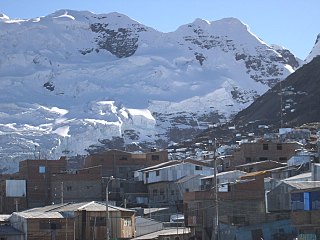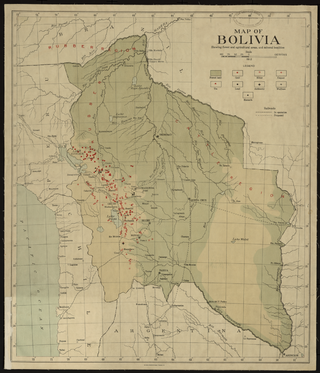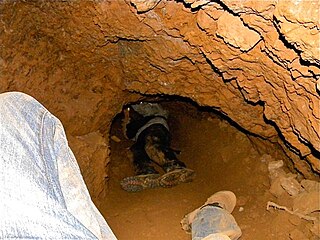
Mining is the extraction of valuable geological materials from the Earth and other astronomical objects. Mining is required to obtain most materials that cannot be grown through agricultural processes, or feasibly created artificially in a laboratory or factory. Ores recovered by mining include metals, coal, oil shale, gemstones, limestone, chalk, dimension stone, rock salt, potash, gravel, and clay. The ore must be a rock or mineral that contains valuable constituent, can be extracted or mined and sold for profit. Mining in a wider sense includes extraction of any non-renewable resource such as petroleum, natural gas, or even water.

Coal mining is the process of extracting coal from the ground or from a mine. Coal is valued for its energy content and since the 1880s has been widely used to generate electricity. Steel and cement industries use coal as a fuel for extraction of iron from iron ore and for cement production. In the United Kingdom and South Africa, a coal mine and its structures are a colliery, a coal mine is called a 'pit', and the above-ground structures are a 'pit head'. In Australia, "colliery" generally refers to an underground coal mine.

Tambogrande is a small town in the Piura Province of the Piura Region in northwestern Peru. One of many small towns chosen as a site for mining development during Peru's mining boom in 1999, Tambogrande achieved prominence for successfully opposing the Manhattan Minerals mining development in the area. Compared to other regions, San Lorenzo has some significant advantages over its neighbors, including access to water and its location near the port of Paita. The city's main industry is the production of lemons and mangoes on the fertile land that surrounds the town, producing almost 40% of lemons in Peru and employing 65% of the population in its agricultural industry. Within the region, 70,000 inhabitants occupy it, and 16,000 inhabitants live in the town. Although there is no data that reports the poverty rate in Tambogrande, it is reported that in cities along the rural coastal area of Peru— such as Tambogrande—64% of inhabitants live on less than a dollar a day.

Newmont Corporation is an American gold mining company based in Greenwood Village, Colorado. It is the world's largest gold mining corporation. Incorporated in 1921, it owns gold mines in Nevada, Colorado, Ontario, Quebec, Mexico, the Dominican Republic, Australia, Ghana, Argentina, Peru, and Suriname. In addition to gold, Newmont mines copper, silver, zinc and lead.

Gold mining is the extraction of gold by mining. World gold production was 3,612 tons in 2022.

The TauTona Mine or Western Deep No.3 Shaft, was a gold mine in South Africa. At approximately 3.9 kilometers (2.4 mi) deep, it was home to the world's second deepest mining operation, rivalled only by the Mponeng Gold Mine, but was closed in 2018.

Yanacocha is a gold mine in the Cajamarca region of the Northern Highlands of Peru. Considered to be the fourth largest gold mine in the world, it produced 0.97 million ounces of gold in 2014. The 251-square kilometer open pit mine is situated about 30 kilometers north of Cajamarca, in high pampa, straddling the watershed. The operation is a joint venture between Newmont Goldcorp, Compañia de Minas Buenaventura (43.65%) and the International Finance Corporation (5%).

Cerro Rico, Cerro Potosí or Sumaq Urqu, is a mountain in the Andes near the Bolivian city of Potosí. Cerro Rico, which is popularly conceived of as being "made of" silver ore, is famous for providing vast quantities of silver for the Spanish Empire, most of which was shipped to metropolitan Spain. It is estimated that eighty-five percent of the silver produced in the central Andes during this time came from Cerro Rico. As a result of mining operations in the mountain, the city of Potosí became one of the largest cities in the New World. It is said that revolutionary hero Simon Bolívar once waved a flag from the top of this monumental mountain in a historic moment that symbolized the founding of a new nation. Just a year later, congress decided to change the colors to yellow-red-green and include a coat of arms featuring the iconic condor, alpaca and Cerro Rico mine.

The Bingham Canyon Mine, more commonly known as Kennecott Copper Mine among locals, is an open-pit mining operation extracting a large porphyry copper deposit southwest of Salt Lake City, Utah, in the Oquirrh Mountains. The mine is the largest man-made excavation, and deepest open-pit mine in the world, which is considered to have produced more copper than any other mine in history – more than 19,000,000 short tons. The mine is owned by Rio Tinto Group, a British-Australian multinational corporation. The copper operations at Bingham Canyon Mine are managed through Kennecott Utah Copper Corporation which operates the mine, a concentrator plant, a smelter, and a refinery. The mine has been in production since 1906, and has resulted in the creation of a pit over 0.75 miles (1,210 m) deep, 2.5 miles (4 km) wide, and covering 1,900 acres. It was designated a National Historic Landmark in 1966 under the name Bingham Canyon Open Pit Copper Mine. The mine experienced a massive landslide in April 2013 and a smaller slide in September 2013.

The Porgera Gold Mine is a large gold and silver mining operation in near Porgera, Enga province, Papua New Guinea (PNG), located at the head of the Porgera Valley. The mine is situated in the rain forest covered highlands at an altitude of 2,200 to 2,700 m, in a region of high rainfall, landslides, and frequent earthquakes.

The health and environmental impact of the coal industry includes issues such as land use, waste management, water and air pollution, caused by the coal mining, processing and the use of its products. In addition to atmospheric pollution, coal burning produces hundreds of millions of tons of solid waste products annually, including fly ash, bottom ash, and flue-gas desulfurization sludge, that contain mercury, uranium, thorium, arsenic, and other heavy metals. Coal is the largest contributor to the human-made increase of carbon dioxide in Earth's atmosphere.

The Mining industry of Ghana accounts for 5% of the country's GDP and minerals make up 37% of total exports, of which gold contributes over 90% of the total mineral exports. Thus, the main focus of Ghana's mining and minerals development industry remains focused on gold. Ghana is Africa's largest gold producer, producing 80.5 t in 2008. Ghana is also a major producer of bauxite, manganese and diamonds. Ghana has 20 large-scale mining companies producing gold, diamonds, bauxite and manganese; over 300 registered small scale mining groups; and 90 mine support service companies.Other mineral commodities produced in the country are natural gas, petroleum, salt, and silver.

Tajikistan has rich deposits of gold, silver, and antimony. The largest silver deposits are in Sughd Province, where Tajikistan's largest gold mining operation also is located. Russia's Norilsk nickel company has explored a large new silver deposit at Bolshoy Kanimansur. More than 400 mineral deposits of some 70 different minerals have been discovered in Tajikistan, including strontium, tungsten, molybdenum, bismuth, salt, lead, zinc, fluorspar, and mercury. These minerals have been found suitable for mining. Uranium, an important mineral in the Soviet era, remains in some quantity but is no longer extracted. The Tajikistan Aluminium Company (TALCO), an aluminium smelter, is the country's only large-scale production enterprise in the mining sector. Tajikistan hosts the annual Mining World Tajikistan, an international exhibition on mining in Dushanbe.

La Rinconada is a town in the Peruvian Andes near a gold mine. At up to 5,100 m above sea level, it is the highest permanent settlement in the world.

Mining in Bolivia has been a dominant feature of the Bolivian economy as well as Bolivian politics since 1557. Colonial era silver mining in Bolivia, particularly in Potosí, played a critical role in the Spanish Empire and the global economy. Tin mining supplanted silver by the twentieth century and the central element of Bolivian mining, and wealthy tin barons played an important role in national politics until they were marginalized by the industry's nationalization into the Bolivian Mining Corporation that followed the 1952 revolution. Bolivian miners played a critical part to the country's organized labor movement from the 1940s to the 1980s.

Mineral industry of Colombia refers to the extraction of valuable minerals or other geological materials in Colombia. Colombia is well-endowed with minerals and energy resources. It has the largest coal reserves in Latin America, and is second to Brazil in hydroelectric potential. Estimates of petroleum reserves in 1995 were 3.1 billion barrels (490,000,000 m3). Colombia also possesses significant amounts of nickel and gold. Other important metals included platinum and silver, which were extracted in much smaller quantities. Colombia also produces copper, small amounts of iron ore, and bauxite. Nonmetallic mined minerals include salt, limestone, sulfur, gypsum, dolomite, barite, feldspar, clay, magnetite, mica, talcum, and marble. Colombia also produces most of the world's emeralds. Despite the variety of minerals available for exploitation, Colombia still had to import substances such as iron, copper, and aluminum to meet its industrial needs.

An artisanal miner or small-scale miner (ASM) is a subsistence miner who is not officially employed by a mining company, but works independently, mining minerals using their own resources, usually by hand.
Mohammed International Development Research and Organization Companies (MIDROC) is a mining and oil company owned by Saudi billionaire Sheik Mohammed Hussein Al Amoudi. It has operations in Europe, the Middle East, and Africa. Through its Corral Petroleum Holdings AB, MIDROC has become a major independent oil company.

The mining industry of Mali is dominated by gold extraction but also produces diamonds, rocksalt, phosphates, semi precious stones, bauxite, iron ore, and manganese. The importance of mining and production of raw minerals has changed throughout time and has involved many foreign stakeholders, most notably France, the former Soviet Union, and South Africa. Gold, followed by cotton, is the top export item, making it a large contributor to the country’s economy. Mineral extraction in the country is done both via industrial mining and artisanal mining, and both methods of production have had profound impacts on the economy, sociocultural landscape, and environment.